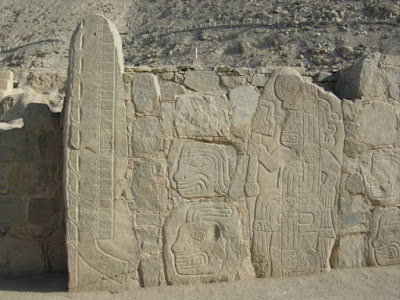 |
| fig. 1 |
Julio C. Tello
was convinced that pre-hispanic Andean cultures were much older than his
contemporaries believed. Up until then scholars such as Max Uhl had focused
primarily on Peru´s coastal civilizations. Tello developed a revolutionary theory
that flew in the face of accepted scientific thinking.
A UNESCO World Heritage site since 1985, Chavín de
Huantar is located on a tributary of the Marañón River, east of Peru’s Cordillera Blanca, near the Callejón de Huáylas.
An
important political and religious centre, at over 3,200 metres above
sea level, it occupies a strategic mountain intersection where many of the major
early routes linking Peru’s tropical rainforests and its desert coast came
together.
In 1919 Tello
was the first archaeologist to make a detailed scientific study of Chavín de
Huantar and its people. He looked upon Chavín
as a kind of ‘mother culture’; an ancient Peruvian civilisation that grew and
spread from this centre in the mountains, sophisticated enough to migrate
downwards to the coastal regions and influence subsequent cultures there.
He later searched all
over the coastal regions of Peru for the signs of Chavín that would validate his theory.
When
in 1937 the expedition team arrived in a coastal valley just over 300km north of
Lima, Tello‘s instincts were on high alert. And they were not wrong. The Casma Valley is home to one of the largest and most ancient monumental sites in Peru, including the
Cerro Sechín temple,
now best known for the macabre monolithic stone
frieze that Tello eventually uncovered and Hernan recorded.
But you have to kiss a lot of frogs…….
Don Timo’s turtle
In which our enthusiastic explorers set out on what proves to be a wild goose chase, or in this case a wild turtle chase
Just before
Mejía Xesspe discovered the Sechín Temple in Sechín
Bajo on the Corrales Mountain, Tello was already excited about the possibility
of an impending discovery. He had seen the Chavinesque stone that was currently
in the possession of a certain Señor Juan Reyna, and although Reyna, along with
everyone else involved, had no idea as to its provenance, Tello believed the
small monolith could only have come from the Casma Valley.
All the more reason then for his delight when an Indian sharecropper from the San Diego Hacienda, Timoteo Reyes, came to him with some information that seemed to provide a trail leading to more discoveries. According to Don Timo he knew a place where there was a stone turtle complete with engravings on its shell.
All the more reason then for his delight when an Indian sharecropper from the San Diego Hacienda, Timoteo Reyes, came to him with some information that seemed to provide a trail leading to more discoveries. According to Don Timo he knew a place where there was a stone turtle complete with engravings on its shell.
“But hear me well Reyes,” said Tello before closing the deal, “we will be ready to leave at precisely eight o’clock in the morning – not a minute more, not a minute less, do you understand?”
“Very well, doctor,” replied the farmer.
The next day eight o'clock arrived and there was no sign of Don Timo. Tello was so punctual you could set your watch by him and he was growing very impatient. Finally the farmer appeared, an hour late. He was looking rather sheepish and dejected and was empty handed but for a shabby, frayed set of reins.
“What’s the meaning of this?”
The next day eight o'clock arrived and there was no sign of Don Timo. Tello was so punctual you could set your watch by him and he was growing very impatient. Finally the farmer appeared, an hour late. He was looking rather sheepish and dejected and was empty handed but for a shabby, frayed set of reins.
“What’s the meaning of this?”
“The horses have run off into the
mountains doctor, we couldn’t catch them, not a single one.”
“Well we’ll just have to walk then,”
snapped Tello.
To make matters worse, the sun by this
time had reached a fierce intensity.
The tramp across the dusty fields and sand dunes was exhausting. Finally
at the foot of a hill, there it was; the sacred turtle!
The archaeologists’ enthusiasm went up
in a puff of smoke. They had set out hoping to find the place from where the
Reyna stone had been extracted, but the closer they came to the turtle, the
less ‘archaeological’ it seemed. It was nothing more than a lot of concentric
circles laid down in stones obviously by some boys who had been playing around
there.
Don Timo protested
lamely. Surely it was a valuable
antiquity. He swore that he had inspected it closely and had seen the form of a
turtle.
The thing that angered Tello most was
not so much that their hopes had been shattered but more seriously the whole
day had been a complete waste of time.
From then on we coined a new phrase to describe the myriad false leads and
disappointments that were an inevitable occurrence during our adventures.
Whenever someone led us up the garden path, it was always… ‘This one’s another Timo from Casma.’
 |
| Sechín |
fig. 1 Hernan's illustration of the Chavínesque stone found at the home of Juan Reyna in Casma
fig. 2 illustrations of pottery pieces and fragments in the Juan Reyna collection
all taken from Arqueologia del Valle de Casma, Julio C Tello


No comments :
Post a Comment